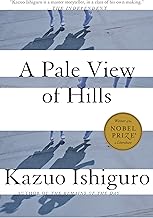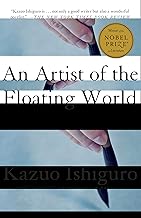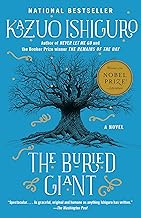
How to Read Kazuo Ishiguro's Books on Reading order
How to Read Kazuo Ishiguro's Books on Reading Order
Estimated Reading Time: 10-12 minutes
Introduction
Kazuo Ishiguro, the Nobel Prize-winning author, is renowned for his profound explorations of memory, identity, and the complexities of human relationships. Born in Nagasaki, Japan, in 1954, and raised in the UK from the age of five, Ishiguro's unique cultural perspective informs his literary voice. His works often grapple with themes of nostalgia and the passage of time, making them rich ground for contemplation and discussion.
In this guide, we will explore Ishiguro's significant contributions to the theme of "Reading order" through three of his notable works: A Pale View of Hills, An Artist of the Floating World, and The Buried Giant. Each book offers a distinct lens on the theme, and understanding their interconnectedness will enhance your reading experience.
Why Kazuo Ishiguro's Perspective Matters
Ishiguro's approach to storytelling is marked by a delicate balance of emotional depth and philosophical inquiry. Unlike many contemporary authors, he often employs an understated narrative style, inviting readers to engage deeply with the subtext of his characters' experiences. His exploration of memory and the human condition resonates with readers across cultures and generations, making his insights on "Reading order" particularly valuable.
Ishiguro's work stands apart from other literary figures due to his ability to weave complex themes into seemingly simple narratives. His exploration of the past's influence on the present and the intricacies of personal and collective memory provides a framework for understanding how we construct meaning in our lives. This perspective is especially relevant in today's fast-paced world, where the act of reading can often feel fragmented and disjointed.
Overview of Recommended Books
A Pale View of Hills
A Pale View of Hills is Ishiguro's debut novel, published in 1982. It introduces readers to Etsuko, a Japanese woman living in England, who reflects on her life in post-war Nagasaki. The novel intricately weaves themes of memory, loss, and the complexities of cultural identity.
Main Themes and Arguments:
- Memory and Trauma: The narrative delves into how personal and collective memories shape identity, particularly in the context of war.
- Cultural Displacement: Etsuko's experiences as an expatriate highlight the challenges of reconciling one's past with a new cultural environment.
- Ambiguity of Truth: The novel raises questions about the reliability of memory and the subjective nature of truth.
Key Insights and Takeaways:
- The Nature of Memory: Ishiguro illustrates how memories can be both comforting and haunting, shaping our understanding of self.
- Cultural Identity: The struggle between past and present reflects the broader theme of cultural identity in a globalized world.
- The Complexity of Relationships: Etsuko's interactions reveal the nuances of human connection, particularly in the face of trauma.
Why Read This Book: A Pale View of Hills is essential for understanding how Ishiguro lays the groundwork for his exploration of memory and identity. Readers interested in the psychological dimensions of storytelling will find rich material here, particularly those grappling with their cultural identities.
An Artist of the Floating World
Published in 1986, An Artist of the Floating World follows Masuji Ono, a retired painter reflecting on his life and the role he played in Japan's militaristic past. The novel examines the intersections of art, memory, and moral responsibility.
Main Themes and Arguments:
- Art and Responsibility: Ono's reflections on his past raise questions about the ethical implications of art in society.
- National Identity: The narrative explores how personal and national identities are intertwined, particularly in the aftermath of war.
- The Fallibility of Memory: Like Ishiguro's other works, this novel emphasizes the unreliable nature of memory.
Key Insights and Takeaways:
- Art as a Reflection of Society: Ono's journey illustrates how art can both reflect and influence societal values and beliefs.
- The Weight of the Past: The struggle to reconcile past actions with present realities is a central theme, prompting readers to consider their own histories.
- Subjectivity of Truth: The narrative challenges readers to question the nature of truth and how it is shaped by individual perspectives.
Why Read This Book: An Artist of the Floating World is crucial for understanding Ishiguro's exploration of the moral complexities of memory and identity. It is particularly relevant for those interested in the relationship between art and ethics, as well as the impact of historical narratives on personal identity.
The Buried Giant
Published in 2015, The Buried Giant is a departure from Ishiguro's earlier works, blending elements of fantasy with profound philosophical questions. The story follows an elderly couple, Axl and Beatrice, as they embark on a journey to find their son in a post-Arthurian Britain shrouded in mist and forgetfulness.
Main Themes and Arguments:
- Memory and Forgetting: The novel explores the tension between the desire to remember and the need to forget, particularly in the context of collective trauma.
- Love and Loyalty: Axl and Beatrice's relationship serves as a testament to enduring love, even in the face of adversity.
- The Nature of History: The story raises questions about how history is constructed and the role of memory in shaping collective identity.
Key Insights and Takeaways:
- The Duality of Memory: The novel illustrates that forgetting can be both a burden and a blessing, influencing personal and collective narratives.
- The Power of Love: Axl and Beatrice's journey underscores the importance of love and loyalty in navigating life's challenges.
- Historical Reflection: The narrative invites readers to reflect on how history is remembered and forgotten, prompting deeper engagement with the past.
Why Read This Book: The Buried Giant offers a unique perspective on memory and identity, blending philosophical inquiry with a rich narrative. It is particularly suited for readers interested in the interplay between fantasy and reality, as well as those seeking to explore the complexities of human relationships.
How These Books Complement Each Other
Each of Ishiguro's works builds upon the themes of memory and identity, offering different perspectives and insights. A Pale View of Hills sets the stage for understanding the personal ramifications of memory, while An Artist of the Floating World expands on these ideas by examining the ethical dimensions of memory and art. Finally, The Buried Giant challenges readers to consider the broader implications of forgetting and the construction of history.
Reading these books in succession allows for a deeper understanding of how Ishiguro's exploration of memory evolves across different contexts and narratives. Together, they provide a comprehensive view of the complexities of human experience, making them essential for anyone interested in the theme of "Reading order."
Who Would Benefit from Reading These Books
These works are ideal for a diverse audience:
- Students and Academics: Those studying literature, philosophy, or cultural studies will find rich material for analysis and discussion.
- General Readers: Anyone interested in the intricacies of memory and identity will appreciate Ishiguro's nuanced storytelling.
- Professionals Seeking Practical Wisdom: Individuals in fields such as psychology, art, or history can draw valuable insights from Ishiguro's exploration of ethical dilemmas and the human condition.
- Anyone Looking for Personal Growth: Readers seeking self-improvement will find themes of love, loyalty, and the importance of confronting one's past particularly resonant.
Recommended Reading Order
- Start with: A Pale View of Hills - This debut novel introduces key themes of memory and identity, providing a solid foundation for understanding Ishiguro's work.
- Continue with: An Artist of the Floating World - This book deepens the exploration of memory and moral responsibility, encouraging readers to reflect on the ethical implications of their actions.
- Advanced reading: The Buried Giant - This novel offers a philosophical exploration of memory and forgetting, challenging readers to consider the broader implications of their personal and collective histories.
Tips for Getting the Most Out of Each Book:
- Take notes on recurring themes and motifs as you read.
- Reflect on how each character's experiences relate to your own understanding of memory and identity.
- Engage with supplementary materials, such as interviews or essays about Ishiguro's work, to gain additional insights.
Conclusion
Kazuo Ishiguro's contributions to the theme of "Reading order" are both profound and enduring. His exploration of memory, identity, and the complexities of human relationships invites readers to engage deeply with their own experiences and the world around them. By delving into these three works, readers can gain a comprehensive understanding of Ishiguro's unique perspective and its relevance in today's world.
As you embark on this literary journey, allow yourself to reflect on the themes and insights presented in each book. Ishiguro's work encourages us to confront our pasts, embrace our identities, and navigate the intricate tapestry of human experience. Happy reading!
Tags: #Kazuo Ishiguro #Reading order #Philosophy #ReadingGuide #ClassicLiterature #Wisdom
Featured Books

A Pale View of Hills
by Kazuo Ishiguro
Published: 1982
In this debut novel from acclaimed Booker Prize-winning Kazuo Ishiguro (The Remains of the Day, Never Let Me Go), post-war Japan serves as the haunting backdrop to a subtle story of memory, suicide, and psychological trauma.Etsuko lives alone in rural England, trying to come to terms with the recent suicide of her daughter, Keiko. A visit from her other daughter Niki sends Etsuko retreating into the depths of her memory. She finds herself reliving one particular hot summer in Nagasaki, when she and her friends struggled to rebuild their lives after the horrors of the bomb and WWII. But when her thoughts turn to her strange friendship with Sachiko and Sachiko's daughter Mariko, the memories begin to take on a disturbing cast. As Etsuko examines her relationship with her daughters and struggles to cope with her guilt, the lines between the past and the present-between Etsuko's own daughter and Mariko, between reality and recollection-start to blur. Read the evocative and atmospheric novel that began Kazuo Ishiguro's illustrious literary career. Winner of the Winifred Holtby Prize in 1982, A Pale View of the Hills is still haunting readers decades later. Read more

An Artist of the Floating World
by Kazuo Ishiguro
Published: 1986
From the winner of the Nobel Prize in Literature and author of the Booker Prize–winning novel The Remains of the Day In the face of the misery in his homeland, the artist Masuji Ono was unwilling to devote his art solely to the celebration of physical beauty. Instead, he put his work in the service of the imperialist movement that led Japan into World War II. Now, as the mature Ono struggles through the aftermath of that war, his memories of his youth and of the "floating world"—the nocturnal world of pleasure, entertainment, and drink—offer him both escape and redemption, even as they punish him for betraying his early promise. Indicted by society for its defeat and reviled for his past aesthetics, he relives the passage through his personal history that makes him both a hero and a coward but, above all, a human being. Read more

The Buried Giant
by Kazuo Ishiguro
Published: 2015
NATIONAL BESTSELLER • From the winner of the Nobel Prize in Literature and author of Never Let Me Go and the Booker Prize–winning novel The Remains of the Day comes a luminous meditation on the act of forgetting and the power of memory. In post-Arthurian Britain, the wars that once raged between the Saxons and the Britons have finally ceased. Axl and Beatrice, an elderly British couple, set off to visit their son, whom they haven't seen in years. And, because a strange mist has caused mass amnesia throughout the land, they can scarcely remember anything about him. As they are joined on their journey by a Saxon warrior, his orphan charge, and an illustrious knight, Axl and Beatrice slowly begin to remember the dark and troubled past they all share. By turns savage, suspenseful, and intensely moving, The Buried Giant is a luminous meditation on the act of forgetting and the power of memory. Read more